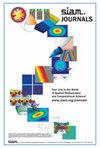半盲图像解卷积中的边际似然估计:随机逼近法
IF 2.3
3区 数学
Q3 COMPUTER SCIENCE, ARTIFICIAL INTELLIGENCE
引用次数: 0
摘要
SIAM 影像科学杂志》,第 17 卷第 2 期,第 1206-1254 页,2024 年 6 月。 摘要:本文提出了一种新颖的随机优化方法,用于在半盲图像解卷积问题中执行经验贝叶斯推理。给定一幅模糊图像和一类可能的算子参数,所提出的优化方法通过最大边际似然估计自动校准模糊模型参数,然后根据估计的模型参数通过最大后验估计进行(非盲)图像解卷积。除了模糊模型外,所提出的方法还能自动校准噪声水平以及任何正则化参数。模糊、噪声和正则化参数的边际似然通常难以计算,因为它需要计算整个解空间的多个积分。我们的方法通过使用随机近似近似梯度优化方案解决了这一难题,该方案通过使用莫罗-尤西达正则化未调整朗之文马尔可夫链蒙特卡罗算法迭代求解这些积分。这种优化策略可以轻松高效地应用于任何对数凹模型,并使用与凸优化计算最大后验解所需的相同梯度和近似算子。我们在现实且易于验证的条件下为所提出的优化方案提供了收敛保证,并随后通过一系列解卷积实验以及与现有替代策略的比较,证明了该方法的有效性。本文章由计算机程序翻译,如有差异,请以英文原文为准。
Marginal Likelihood Estimation in Semiblind Image Deconvolution: A Stochastic Approximation Approach
SIAM Journal on Imaging Sciences, Volume 17, Issue 2, Page 1206-1254, June 2024.
Abstract.This paper presents a novel stochastic optimization methodology to perform empirical Bayesian inference in semi-blind image deconvolution problems. Given a blurred image and a parametric class of possible operators, the proposed optimization approach automatically calibrates the parameters of the blur model by maximum marginal likelihood estimation, followed by (non-blind) image deconvolution by maximum a posteriori estimation conditionally to the estimated model parameters. In addition to the blur model, the proposed approach also automatically calibrates the noise level as well as any regularization parameters. The marginal likelihood of the blur, noise, and regularization parameters is generally computationally intractable, as it requires calculating several integrals over the entire solution space. Our approach addresses this difficulty by using a stochastic approximation proximal gradient optimization scheme, which iteratively solves such integrals by using a Moreau–Yosida regularized unadjusted Langevin Markov chain Monte Carlo algorithm. This optimization strategy can be easily and efficiently applied to any model that is log-concave and by using the same gradient and proximal operators that are required to compute the maximum a posteriori solution by convex optimization. We provide convergence guarantees for the proposed optimization scheme under realistic and easily verifiable conditions and subsequently demonstrate the effectiveness of the approach with a series of deconvolution experiments and comparisons with alternative strategies from the state of the art
Abstract.This paper presents a novel stochastic optimization methodology to perform empirical Bayesian inference in semi-blind image deconvolution problems. Given a blurred image and a parametric class of possible operators, the proposed optimization approach automatically calibrates the parameters of the blur model by maximum marginal likelihood estimation, followed by (non-blind) image deconvolution by maximum a posteriori estimation conditionally to the estimated model parameters. In addition to the blur model, the proposed approach also automatically calibrates the noise level as well as any regularization parameters. The marginal likelihood of the blur, noise, and regularization parameters is generally computationally intractable, as it requires calculating several integrals over the entire solution space. Our approach addresses this difficulty by using a stochastic approximation proximal gradient optimization scheme, which iteratively solves such integrals by using a Moreau–Yosida regularized unadjusted Langevin Markov chain Monte Carlo algorithm. This optimization strategy can be easily and efficiently applied to any model that is log-concave and by using the same gradient and proximal operators that are required to compute the maximum a posteriori solution by convex optimization. We provide convergence guarantees for the proposed optimization scheme under realistic and easily verifiable conditions and subsequently demonstrate the effectiveness of the approach with a series of deconvolution experiments and comparisons with alternative strategies from the state of the art
求助全文
通过发布文献求助,成功后即可免费获取论文全文。
去求助
来源期刊

SIAM Journal on Imaging Sciences
COMPUTER SCIENCE, ARTIFICIAL INTELLIGENCE-COMPUTER SCIENCE, SOFTWARE ENGINEERING
CiteScore
3.80
自引率
4.80%
发文量
58
审稿时长
>12 weeks
期刊介绍:
SIAM Journal on Imaging Sciences (SIIMS) covers all areas of imaging sciences, broadly interpreted. It includes image formation, image processing, image analysis, image interpretation and understanding, imaging-related machine learning, and inverse problems in imaging; leading to applications to diverse areas in science, medicine, engineering, and other fields. The journal’s scope is meant to be broad enough to include areas now organized under the terms image processing, image analysis, computer graphics, computer vision, visual machine learning, and visualization. Formal approaches, at the level of mathematics and/or computations, as well as state-of-the-art practical results, are expected from manuscripts published in SIIMS. SIIMS is mathematically and computationally based, and offers a unique forum to highlight the commonality of methodology, models, and algorithms among diverse application areas of imaging sciences. SIIMS provides a broad authoritative source for fundamental results in imaging sciences, with a unique combination of mathematics and applications.
SIIMS covers a broad range of areas, including but not limited to image formation, image processing, image analysis, computer graphics, computer vision, visualization, image understanding, pattern analysis, machine intelligence, remote sensing, geoscience, signal processing, medical and biomedical imaging, and seismic imaging. The fundamental mathematical theories addressing imaging problems covered by SIIMS include, but are not limited to, harmonic analysis, partial differential equations, differential geometry, numerical analysis, information theory, learning, optimization, statistics, and probability. Research papers that innovate both in the fundamentals and in the applications are especially welcome. SIIMS focuses on conceptually new ideas, methods, and fundamentals as applied to all aspects of imaging sciences.
 求助内容:
求助内容: 应助结果提醒方式:
应助结果提醒方式:


